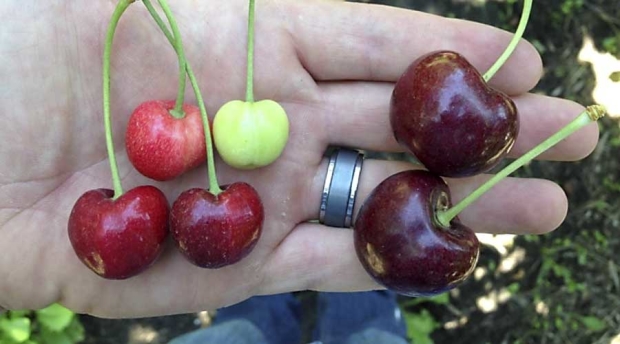
Bing cherries showing symptoms of little cherry disease on left, with healthy cherries on right. (Courtesy Washington State Univeristy)
As little cherry disease continues to gain a foothold in Northwest cherry orchards, growers are finding that one of the biggest concerns is knowing whether trees that show no symptoms of the disease might still carry it and need to be pulled.

Dr. Andrea Bixby-Brosi
“It’s hard to recommend how growers should proceed in terms of how many trees to remove, because we do have confusion about non-symptomatic trees that carry the disease,” Dr. Andrea Bixby-Brosi, a postdoctoral research assistant at Washington State University’s Tree Fruit Research and Extension Center, told growers at the Washington State Tree Fruit Association Annual Meeting in December. “Year after year, growers think they have it under control, and then the following year, there’s more infection.”
Three pathogens are associated with little cherry disease: little cherry virus strain 1, little cherry virus strain 2 and Western X.
Infected trees produce small, poorly colored cherries that lack sugar and have a bitter flavor.
Determining how and when growers can reasonably predict a percentage of positive trees that show no symptoms from the disease is part of the focus of a research project that also involves entomologist Dr. Elizabeth Beers, virologist Dr. Ken Eastwell, agricultural economist Dr. Karina Gallardo, and extension specialist Tim Smith.
The team sampled 250 trees in four orchards — some randomly and some within a one- to three-tree radius of a previously identified positive tree — to determine which were positive for the disease.
Field representatives then walked through the orchards to mark the trees they thought were positive and negative based on size, color and taste of the cherries.
The goal was twofold: to see if infected trees could be easily identified and to determine if more education is needed for workers in the orchard.
The researchers also surveyed for mealybugs in the orchards to determine if their presence is an indicator for the disease, but none had any mealybugs.
“So, mealybug can be a red flag, but it doesn’t mean an infected orchard has to have an active mealybug population,” Bixby-Brosi said. (Read more about Bixby-Brosi’s mealybug research update)
She shared results of the research from two of the four orchards.
—Orchard 1:
Tests confirmed little cherry virus 2 in 2010 or 2011, with additional cases identified from 2013 to 2015. During a walk-through last year, at least three of 10 field workers flagged all the positive trees.
However, 85 negative trees were tagged as “suspect positive” by at least one worker — though Bixby-Brosi noted the walk-through occurred early in the season, when workers might not yet be adept at recognizing symptoms.
All but five of the positive trees were located within a one- to two-tree radius of a tree that was known to be positive in the past. None of the randomly selected trees tested positive for the disease.
—Orchard 2:
Tests confirmed both little cherry virus strain 2 and Western X.
Researchers sent six field workers through the field. Of the seven trees positive for little cherry virus strain 2, only three were flagged by at least one field worker, and four trees were not flagged by anyone.
The trees did not have any symptoms, but all were located within a three-tree radius of either a positive or suspect-positive tree. Four suspect trees tested positive for Western X.
None of the randomly selected trees had the disease.
Overall, the researchers found that most of the additionally infected trees were located within a three-tree radius of previously positive trees and that random sampling is not an effective sampling method, Bixby-Brosi said.
She recommended that growers ensure the root system of an infected tree is dead when removing it, because suckers from the root system also test positive for the disease.
“For whole orchards, we don’t have a recommendation yet, but we’ve been hearing from growers who’ve been replanting that fumigation alone may not be enough, because some of that root system is still alive in the orchard.”
The research continues this year. •
PLAY
Andrea Bixby-Brosi updates growers about little cherry virus research. Watch the video below:
– by Shannon Dininny






Leave A Comment